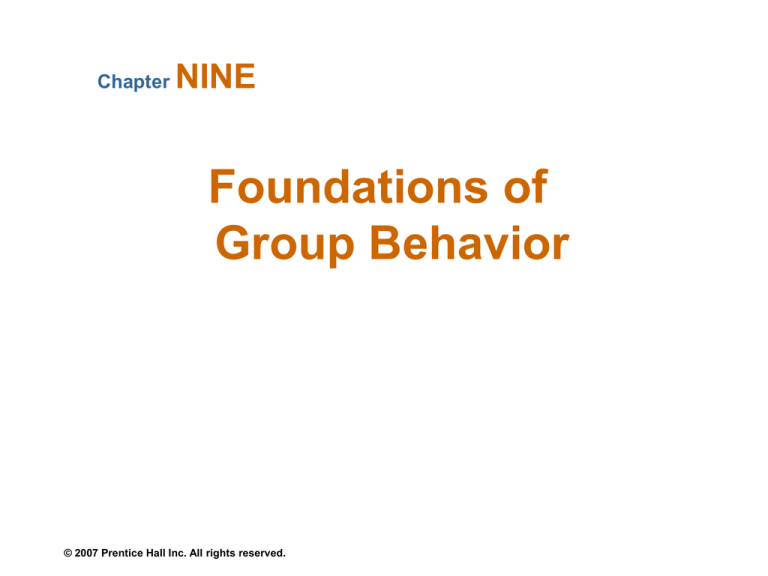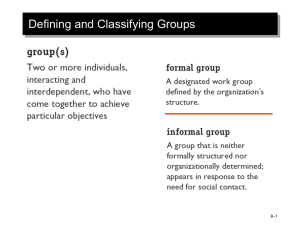
Chapter
NINE
Foundations of
Group Behavior
© 2007 Prentice Hall Inc. All rights reserved.
Defining and Classifying Groups
Group(s)
Two or more individuals interacting and
interdependent, who have come together to
achieve particular objectives
Formal Group
Informal Group
A designated work group
defined by the
organization’s structure
A group that is neither formally
structured nor organizationally
determined; appears in
response to the need for social
contact
© 2007 Prentice Hall Inc. All rights reserved.
Defining and Classifying Groups (cont’d)
Command Group
Task Group
A group composed of the
individuals who report
directly to a given
manager
Those working together to
complete a job or task
Interest Group
Friendship Group
Those working together to
attain a specific objective
with which each is
concerned
Those brought together
because they share one
or more common
characteristics
© 2007 Prentice Hall Inc. All rights reserved.
Why People Join Groups
• Security
• Status
• Self-esteem
• Affiliation
• Power
• Goal Achievement
© 2007 Prentice Hall Inc. All rights reserved.
The Five-Stage Model of Group Development
Forming Stage
The first stage in group development, characterized by
much uncertainty
Storming Stage
The second stage in group development, characterized
by intragroup conflict
Norming Stage
The third stage in group
development, characterized
by close relationships and
cohesiveness
© 2007 Prentice Hall Inc. All rights reserved.
…Group Development (cont’d)
Performing Stage
The fourth stage in group development, when the group
is fully functional
Adjourning Stage
The final stage in group
development for temporary
groups, characterized by
concern with wrapping up
activities rather than
performance
© 2007 Prentice Hall Inc. All rights reserved.
Stages of Group Development
E X H I B I T 9–2
© 2007 Prentice Hall Inc. All rights reserved.
Problems with the five-stage model
• Many assume that a group becomes more effective as it
progresses through the first four stages. While generally true,
what makes a group effective is more complex. Under some
conditions, high levels of conflict are conducive to high group
performance.
• Groups do not always proceed clearly from one stage to the
next. Sometimes several stages go on simultaneously, as when
groups are storming and performing. Groups even occasionally
regress to previous stages.
• Another problem is that it ignores organizational context. For
instance, a study of a cockpit crew in an airliner found that,
within ten minutes, three strangers assigned to fly together for
the first time had become a high-performing group.
• The strong organizational context provides the rules, task
definitions, information, and resources needed for the group to
perform.
© 2007 Prentice Hall Inc. All rights reserved.
Group Properties
Roles
Norms
Status
Cohesiveness
© 2007 Prentice Hall Inc. All rights reserved.
Group Properties—Roles
Role(s)
A set of expected behavior patterns attributed to
someone occupying a given position in a social unit
Role Identity
Certain attitudes and behaviors
consistent with a role
Role Perception
An individual’s view of how he or she is
supposed to act in a given situation
© 2007 Prentice Hall Inc. All rights reserved.
Group Properties—Roles (cont’d)
Role Expectations
How others believe a person
should act in a given situation
Psychological Contract
An unwritten agreement that sets out
what management expects from the
employee and vice versa
Role Conflict
A situation in which an individual is confronted
by divergent role expectations
© 2007 Prentice Hall Inc. All rights reserved.
Group Properties—Norms
Norms
Acceptable standards of behavior within a group that
are shared by the group’s members
Classes of Norms
• Performance norms
• Appearance norms
• Social arrangement norms
• Allocation of resources norms
© 2007 Prentice Hall Inc. All rights reserved.
Group Norms and the Hawthorne Studies
A series of studies undertaken by Elton Mayo at
Western Electric Company’s Hawthorne Works in
Chicago between 1924 and 1932
Research Conclusions
– Worker behavior and sentiments were
closely related.
– Group influences (norms) were significant
in affecting individual behavior.
– Group standards (norms) were highly
effective in establishing individual worker output.
– Money was less a factor in determining worker
output than were group standards, sentiments, and
security.
© 2007 Prentice Hall Inc. All rights reserved.
Group Properties—Norms (cont’d)
Conformity
Adjusting one’s behavior to align with
the norms of the group
ASCH
STUDY
Reference Groups
Important groups to which
individuals belong or hope to
belong and with whose norms
individuals are likely to
conform
© 2007 Prentice Hall Inc. All rights reserved.
EXHIBIT 9–4
Group Properties—Status
Status: A socially defined position or rank given to groups or
group members by others
Power over
Others
Ability to
Contribute
Personal
Characteristics
Norms and
Interaction
Group Member
Status
Other things influencing or
influenced by status
Status Inequity
© 2007 Prentice Hall Inc. All rights reserved.
National Culture
Group Properties—Size
Social Loafing
The tendency for individuals to expend less effort when
working collectively than when working individually
Performance
Other Conclusions
• Odd number groups do
better than even.
• Groups of 5 to 7 perform
better overall than larger
or smaller groups.
Group Size
© 2007 Prentice Hall Inc. All rights reserved.
Group Properties—Cohesiveness
Cohesiveness
Degree to which group members are attracted to each
other and are motivated to stay in the group
Increasing Group Cohesiveness
1.
2.
3.
4.
Make the group smaller.
Encourage agreement with group goals.
Increase time members spend together.
Increase group status and admission
difficultly.
5. Stimulate competition with other groups.
6. Give rewards to the group, not individuals.
7. Physically isolate the group.
© 2007 Prentice Hall Inc. All rights reserved.
Relationship Between Group Cohesiveness,
Performance Norms, and Productivity
E X H I B I T 9-7
© 2007 Prentice Hall Inc. All rights reserved.
S. Adams, Build a Better Life by Stealing Office Supplies (Kansas City MO: Andrews &
McMeal, 1991), p. 31. Dilbert reprinted with permission of United Features Syndicate, Inc.
© 2007 Prentice Hall Inc. All rights reserved.
E X H I B I T 9–8
Chapter Check-up: Groups
Lorraine is a non-traditional student (she’s 51
years old) and is working in a group for a class
project. They keep turning to her for the answers
to questions. Which of the following might the
group have that is driving Lorraine’s experience?
Groupthink
Groupshift
Role Conflict
Role Expectations
The group may have role expectations of Lorraine—e.g.,
because she’s older, she should be the wise one and
know the answers like a parent should.
© 2007 Prentice Hall Inc. All rights reserved.








